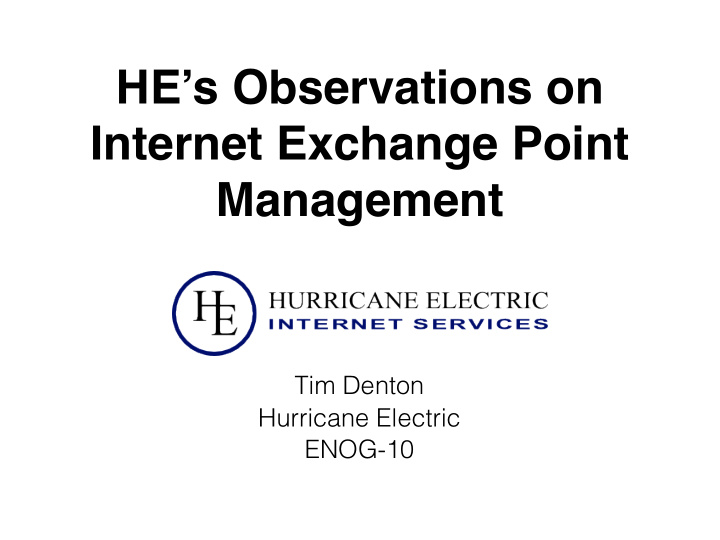



HE’s Observations on Internet Exchange Point Management Tim Denton Hurricane Electric ENOG-10
Background Hurricane Electric (HE) participates in more than 100 Internet exchanges around the world. I’m here to present our experiences and my reflections on how exchange point operators can attract members and promote peering.
Things that Help us Most List participants on your website including their AS numbers, switch-fabric IPv4 and IPv6 addresses, and peering contact information. Make sure we can find your exchange in public directories.
Why List Participants? Both current and prospective participants need this information to add peering sessions, increase peered traffic, and grow revenue. Network operators continuously evaluate additional IXPs for potential expansion. To make this determination they need participant AS numbers and, ideally, to see what prefixes those peers advertise to a route-server at the exchange.
Example: Seattle IX (SIX) Members Page https://www.seattleix.net/participants.htm
Machine-Readable Format Since 2007 there has been a global standard for publishing this information in a machine-readable format: http://www.oecd.org/officialdocuments/publicdisplaydocumentpdf/? cote=DSTI/ICCP/CISP(2007)9&docLanguage=En. More recently RIPE has begun work on a competing European standard: https://ripe70.ripe.net/presentations/96-inex-ripe-connectwg- amsterdam-2015-05-13.pdf
Get Your Exchange Listed Publicly
Get Your Exchange Listed Publicly You put extensive effort into starting and running your exchange: You talked to network operators and recruited the participation. You negotiated with data center operators for space to install exchange switches. You obtained, deployed, and maintain hardware for the exchange. You catalyze ongoing communication between your participants. Taking the last step, publicizing your exchange, maximizes its value both to current participants and to those who could benefit from it.
https:// www.pch.net/ixpdir Email ixps@pch.net or talk with any PCH staffer you may encounter at a network operations meeting to get your exchange added.
https:// www.peeringdb.com Entries are created by network operators, not exchange operators. Encourage all your members to register and list themselves as being connected to your exchange - they will need to make the request to list your exchange.
https:// wikipedia.org/wiki/ List_of_Internet_exchange _points Edit IXP list article to include information about your exchange. Monitor in case your entry is edited by others Consider creating a stand- alone Wikipedia article about your exchange.
http:// www.internetexchange map.com No action needed: TeleGeography will pick up your information automatically if you are listed in the PCH IXP directory.
Other Suggestions Be the Ethernet switch fabric your participants expect and need, and nothing more. ISPs operate Layer 3 networks, which run on top of a Layer 2 substrate, in this case your Internet exchange. Maintaining a clear boundary separation and division of responsibilities allows everyone to do the job that they expect to do, minimizes costs, and preempts unpleasant surprises. Don’t charge usage based fees on exchange traffic, and try not to charge more for faster ports. Don’t penalize the thing you want more of, and you want traffic to grow! More traffic is more profit for everybody! Don’t try to force every participant to peer with every other participant. This will scare larger networks away, and hinder growth.
Other Suggestions Remember there are 500 other exchange points out there, and among them are a diversity of examples of both success and failure, and many potential solutions to every problem. Their operators are your friends and colleagues, don’t be afraid to ask them for advice and assistance. A global not-for-profit organization, Packet Clearing House, was formed in 1994 by the Internet industry specifically to support the growth of Internet Exchange Points and other critical Internet infrastructure. PCH has provided training, logistics, and equipment to hundreds of exchange points over more than twenty years and is there to support you at no cost.
What does Hurricane Electric look for in an exchange?
Benefits When Hurricane Electric connects to a new exchange, we are trying to achieve these goals: Reduce average per-bit delivery cost (APBDC) Increase supply of bandwidth to keep up with growing demand Improve quality: reduce loss, latency, out-of-order delivery and jitter Meet and connect new potential customers
Evaluation Criteria Correlation of Netflow analysis of current traffic sources and destination ASes with the ASes participating in the exchange Number of networks present in the data center where the exchange is hosted and those nearby or easily reachable Reasonably priced dark fiber cross-connects within the data center Availability of dark fiber between the exchange facility and our customers and other data centers Cost of long-haul circuits from the nearest existing Hurricane Electric points of presence (POPs) to the exchange’s location
Limitations on Participation Internet Service Providers with a naive conception of Internet economics sometimes try to preclude competition through barriers to new market entry. An example of this is the occasional misguided requirement that only network operators licensed as ISPs by the local regulator may participate in the exchange. This is self defeating because it precludes the participation of both the content providers that customers want to reach and the international participants that local ISPs must pay to reach through transit. This restriction limits the growth of the exchange, further reducing its attractiveness to new participants in a cycle of unfortunate unintended consequences.
Logistics Can a global shipping company (ex. FedEx, UPS, or DHL) perform door-to-door delivery in the country and charge all customs duties and taxes to the shipper? Customs should be professional, transparent, and streamlined to facilitate business. Duties and taxes should be remitted directly to the government by the shipping company, and if there are any “special services fees,” we don’t want to hear about it. Irregular and opaque customs processes hinder business and particularly curtail growth of the Internet and telecom sector, which is so dependent on frequent equipment upgrades.
Conclusions Listing your members on your website and on public directories is simple, helps your exchange grow, and supports your members. Large networks rely on public membership information when making decisions about where to put equipment. Imposing fees and license requirements to join your exchange will stifle its growth. Certain telecommunications regulations and non-standard customs processes in your country may further discourage foreign networks from joining.
Thank You! Questions?
Recommend
More recommend